One of the neat things about unearthing a barn, shed or storage find is that first time the car comes into the light of day, or at least the first time for a while. It looks like we have some pictures of that occasion in the eBay listing for this 1959 Pontiac Bonneville. The seller is putting up some of their projects for sale (there’s a 1949 Chrysler and a 1977 AMC Pacer going up for auction as well here) at no reserve. The cars are located in DeLand, Florida. Right now the bidding for this Bonneville is starting at $1,959.
The seller (not sure if we’re looking at him or not) tells us that the car is all original except for the wheels. The instrument cluster has been removed but comes with the car, unlike the fender skirt that is visible in one picture but not included–presumably the seller is keeping it for the 1959 Bonneville convertible that they have purchased to replace this project.
The car actually looks surprisingly solid, and is one of 27,769 two door Bonneville hardtops produced in 1959. The term “wide-track” was coined for this model year, and here’s what Popular Science wrote about the 1959 Pontiacs: “In looks and behavior, the Pontiac, in a manner of speaking has moved into a better neighborhood, it’s no longer merely an older, gawky brother of the Chevrolet.”
This is said to be the original 389 cubic inch V8 engine, and look at that period air conditioning compressor! I wonder if it can be made to work again? The original “hydromatic” automatic transmission is also still in place.
Can you imagine seeing upholstery like this in a modern car? Wow–this must have been totally spectacular at the time! Unfortunately, I’m sure it will all need to be replaced, but you’re going to be doing that eventually anyway. Me, I’d love to get it running as-is for the moment; I even like the late model GM truck steel wheels, to be honest. For some reason I always think old-timey NASCAR when I see one of these 1959s–do you think it would look nice in your garage?
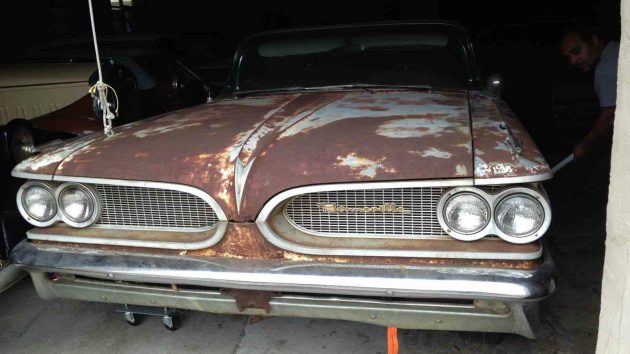
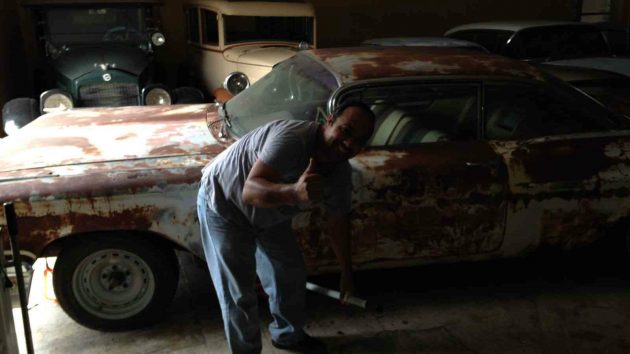
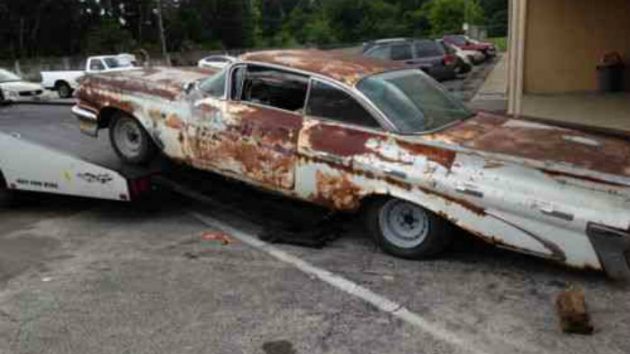
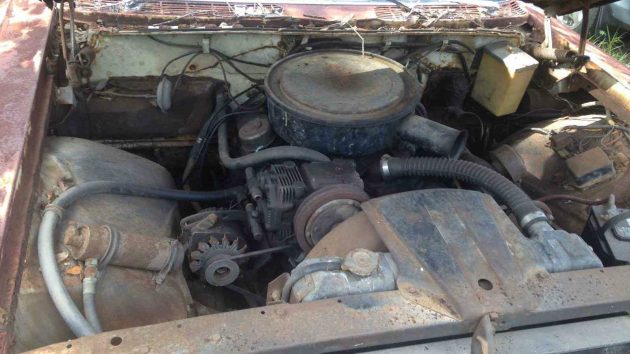
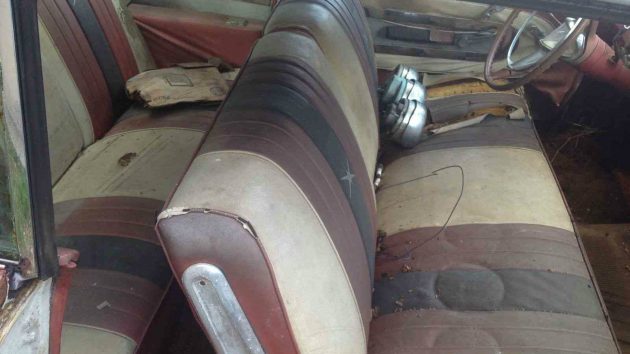


Wow – compare this design to that rambler posted previously. Both for sale in 1959. I’m surprised they sold ANY ramblers…
Pontiac was selling performance and style, Rambler under Romney was selling practicality.
RE: getting old A/C systems working- not as difficult as you might think Refrigeration systems (when everything is still connected and no serious leaks) are sealed, filled with oil along with refrigerant and not affected by humidity, etc. like other components. If you don’t mind the cost of R-12, can often be made to work again.
this might’ve used r22?
This aircraft carrier wouldn’t fit in my garage! I love it though. These were, and are some of the more spectacular cars from GM ever. I loved the three tone interiors, the low swoopy bodies. This car needs everything, but they are rare now, so it’s well worth a good restoration.
Love it. Seats are a statement, enough chrome to please a fussy buyer. I was definitely born in the wrong era….
The seller sounds like he is very accommodating to the buyer, very nice.
Until a couple of years ago I would have agreed completely with Tony S. How did Rambler ever sell any cars when the competition was the awesome styling from GM Ford and Chrysler?
What happened a couple of years ago was that I became involved in the auto body parts business.
As a learner even though I’m past retirement age I’ve received an immersion course in fit and finish accompanied by the history of what was the Big Four in the 50s and 60s.
It turns out that while GM, Ford and Chysler focused on styling and power, Rambler aka AMC focused on engineering, fit, finish, safety and fuel economy. That put Rambler about 70 years ahead of the other auto makers in their thinking and product goals.
Their customer base always seemed to be old men. With age often comes wisdom. Enough wisdom to keep AMC going until 1987.
At that point emissions research and tooling costs finally made AMC vulnerable to takeover.
Chrysler in its own infinite wisdom adopted many AMC techniques and that helped save Chrysler at the time. Today most small car styling globally can trace its roots to first the Gremlin and secondly the Pacer.
Automotive design is a curious blend of styling and engineering. Put too much emphasis on styling and you have a great looking (maybe) car built on impractical structure. Fire the stylists (as Rambler did) and hand the ball to engineers and you get a well built tank that looks like an upside down bathtub.
Consequently, Rambler had a core of customers who like most engineers, had/have little or no sense of proportion, styling or artistic flair in general. Agility was an unknown concept in nearly the entire automotive product range in North America and most cars handled like landing barge with brakes to match. Ignition systems were universally crude and prone to failure. Amazingly European cars were remarkably worse in every aspect except handling.
The bottom line though was that from the mid 50s to the 80s Rambler/AMCs were better built. Where this showed up most clearly was in the new car warranties.
AMC brought in its industry leading 50,000 mile warranty and backed it up even when it was clear the cars were raced on and modified for the drag strips.
By contrast GM, Ford and Chrysler actively hunted for reasons to cancel warranties.
The bottom line was that people who were conscious of their own bottom lines were buying Ramblers to protect their bottom lines.
These days AMCs are still going strong with no corporate support, still competitive and being kept that way by an international army of backyard mechanics.
Indeed AMC cars continue to attract new fans – especially when they find out how amazing the very last AMC Rebel – THE MACHINE is. It stands as the best all around car AMC ever built, the fastest quarter miler tested by the performance magazines (SUPERSTOCK, Rodger and Superstock) at 12.73 and the best handling of any intermediate size car of its era and as good as any today. As a result their value is rising sharply.
This Rebel Machine is typical of what is out there lurking in barns waiting for a new lease on life.
That was a good read, thanks.
Thanks John, being from Milwaukee, we had many friend’s and neighbors who worked at AMC. They were very proud of what they made( until the end, of course) It seems we were constantly defending our beloved Rambler’s, and always were looking for the proper rebuttal. I believe you nailed it.
All that car, and so little room for occupants, which is the primary reason for a car. And only two doors
Danny, that comment tells me you either lived through those decades and somehow didn’t get what they were about or are too young to know.
Old cars starting in the 50s until the mid 70s and the earlier ones especially that were hot rodded were all about the driver and the driver’s ego or self image. Self realization blossoming out of centuries of blind obedience to our elders. The car owners or more importantly the guy who was going to buy the next car had assumed power. Certainly by far the cars sold were mere transportation with four doors.
But the brand image rested on the street racers which was what all two door hard tops were in reality. They represented freedom for the common man in a way that has never ever existed in world history.
Another thing these cars had was trunk space, and distance from the car behind you. That saved lives. Especially if the trunk was full. There was lots of room for passengers.
That’s a whole lot of real state behind the rear window! Imagine the shock on the face of the painter when the boss says “The customer wants it shot in gloss black”
Hey Jeffro, here’s a trunk for ya’!! :)
What a find, 2 doors like this, were pretty rare. Most I remember were wagons or 4 door family movers. In one of my many cruises through the UP (der hey) I came upon a farm that had a black ’59 Poncho convertible out front. I slowed, it looked clean, as I got closer, I was horrified to see, this enterprising Yooper, turned it into the worst rendition of a Batmobile I had ever seen. I couldn’t believe they did that to such a nice car.
Those big trunks would fit three of your friends (better if two were female) when you went to the drive-in. 😄
Where is John DeLorean who fix it right up
Having worked on many AMC’s from the 40’s to the 70’s, seems like they did everything backwards from the big 3; they used the trunnion front end when all others went to ball joints.the sixes of the 40’s ran ok but oil pressure was a problem, even after a rebuild.Alternators- Motorola. Electronic ignition was theirs and it was a bear. Automatic trannys- sometimes ford, then later went to Mopars torquefliight.And in the late 60’s and70’s they used Dowgard antifreeze, which ate up the cooling system; once your coolant turned rusty from this crap, there was no turning back. My customers loved em and continued to buy them. The performance cars were fast and well executed, other than that they should have stuck to making Kelvinator refrigerators…
Gaspumpchas, everything you said was true. But every make had its pitfalls. Poor styling in the Nash, Rambler and most of the AMC line up was what killed the company in the end. No sense of proportion.
In the early 50’s Nash hired internationally renowned Italian automotive designer Pina Farina to design the next generation of cars for them. His offering was almost exactly like the 1996 Jaguar except for the bumpers. AMC paid him and transformed his design into what we all now remember as the UPSIDE DOWN BATHTUB.
Somehow in 1967, AMC’s styling suddenly went right for them until the demise of the 1974 Javelin.
The AMX III if it had made it to market and some other models AMC were never able to bring to market was truely a revolutionary mid-engine sports car that would have done a lot to reshape AMCs fortunes. Especially the very first minivan that really was mini but you could have put a 401 in it.
Good styling resurfaced briefly with the later Spirit cars that together with the Gremlins and Hornets, make some of the very best drag racing cars.
After that it was a long, dark tunnel to oblivion and take over by Chrysler.
I’m an old guy, going to my 50th high reunion this Saturday. Still not sure I want to go but……….
In 1970, I’d been out of the country for 2 years doing some volunteer religious work. My mom bought me a 1959 Pontiac Bonneville 4 dr sedan, about the last kind of car I wanted but it was what she could afford. It had belonged to a guy who’d been a city councilman and then the Mayor in Salt Lake City, and she worked with his son.
The car ran great, decent shape, we put new tires on it and then within a year, I had a job etc and talked my dad into helping me buy a ’69 Roadrunner. Big mistake but that’s another story.
I really like that Pontiac and went on to own 4-5 more over the years.
Love to hear a little bit about the road runner; come on, was it that bad?
What n nice car a must have will make place or even build
a garage for it to live in!!
In 1960 I saw a 59 Pontiac promo that when you turn it over, there was a little slide lever you would push back and forth and it showed you the difference between regular track size and wide-track by moving the wheels in and out. Have not seen one since………….
@ Howard, Rolf Poncho 455,
Wasn’t the wide track about an inch on each side? Help us out guys.
No, more then that…………
Clay, they also had a static display like that, with the front end of some lesser width car superimposed over the front of the 59 Poncho. Don’t remember the slider but it makes sense that it might have been in the salesman orientation packet. Great era for innovations! Oh yeah, when the AMC Pacer came out, a similar campaign evolved with skinnier cars being photographed with the “wider small car.”
My Dad had a 59 Bonneville 2dr Hdtp, the same White with the same multicolored white and maroon interior. It was one of the most beautiful cars he ever owned and he had quite a few. I loved that car, but I am beyond believing that I could afford to resurrect one back to the condition that I would love to see it in with my meager retirement check.